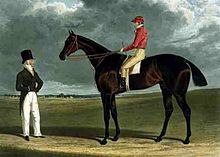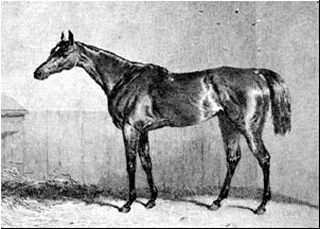
Oxygen was a British Thoroughbred racehorse and broodmare who won the classic Oaks Stakes at Epsom Downs Racecourse in 1831. In a racing career which lasted from July 1830 until April 1833 she won eight of her fifteen races and finished second on five occasions. Oxygen's Oaks was the last of twenty classic wins for her owner George FitzRoy, 4th Duke of Grafton.

Charlotte West was a British Thoroughbred racehorse and broodmare who won the seventeenth running of the classic 1000 Guineas at Newmarket Racecourse in 1830. In a racing career which lasted from April 1830 until May 1831 the filly ran seven times and won four races. After winning the 1000 Guineas on her second racecourse appearance, Charlotte West was beaten when favourite for the Oaks Stakes but returned to win races at Ascot and Newmarket before the end of the year. She failed to reproduce her best form in 1831 and was retired from racing.
Galantine was a British Thoroughbred racehorse and broodmare who won the eighteenth running of the classic 1000 Guineas at Newmarket Racecourse in 1831. Running exclusively at Newmarket, the filly ran eleven times and won four races in a racing career which lasted from April 1830 until May 1831. After being beaten in both her races as a two-year-old, Galantine won a controversial race for the 1000 Guineas on her three-year-old debut, beating the odds-on favourite Oxygen. Although she was considered a lucky and sub-standard classic winner, Galantine went on to win three match races at before the end of the season. She was retired from racing after two unsuccessful runs in 1832.

Galata (1829–1848) was a British Thoroughbred racehorse and broodmare who won two British Classic Races in 1831 and the Ascot Gold Cup a year later. In a racing career which lasted from April 1832 until June 1834 the filly ran ten times and won seven races. As a three-year-old in 1832 she won her first four races including the 1000 Guineas at Newmarket Racecourse and the Oaks Stakes at Epsom Downs Racecourse. In the following year she was unbeaten in two races, winning the Port Stakes at Newmarket and the Gold Cup at Ascot. She was retired to stud after two unsuccessful starts in 1834.
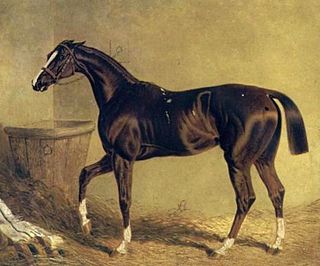
Camarine was a British Thoroughbred racehorse and broodmare. After finishing second on her only start as a two-year-old, Camarine was undefeated for the next three years, winning thirteen consecutive races at distances ranging from five furlongs to two and a half miles. Her dominance over her contemporaries was compared to that of Eclipse sixty years earlier.
May-day was a British Thoroughbred racehorse who won the classic 1000 Guineas at Newmarket Racecourse in 1834. On her only subsequent start she was fatally injured in the Oaks Stakes at Epsom.
Tarantella was a British Thoroughbred racehorse and broodmare who won the classic 1000 Guineas at Newmarket Racecourse in 1833. After winning the Guineas in her third race, Tarantella was unplaced when favourite for the Oaks Stakes and was well-beaten in two other races later that year. She won two minor races in the following year and was retired from racing having won four times from nine starts between October 1832 and August 1834. She was later exported to France where she proved to be a successful broodmare.

Vespa was a British Thoroughbred racehorse and broodmare who won the classic Oaks Stakes at Epsom Downs Racecourse in 1833. The filly's win at Epsom, a 50/1 upset, was the only success in her first two seasons of racing. She produced her best form as a four-year-old when she won four times, including three important races at Newmarket Racecourse. At the end of her British racing career she was sold and exported to Hungary.
Variation (1827–1847) was a British Thoroughbred racehorse and broodmare that achieved success in the racing world. In 1830, Variation made her racing debut by winning the classic Oaks Stakes at Epsom Downs Racecourse. Throughout her career, she participated in fifteen races and emerged victorious in eight of them. Her achievements included three match races, the Oatlands Stakes, and two editions of the Garden Stakes at Newmarket Racecourse. One of her notable victories came in the 1831 Garden Stakes, where she triumphed over a formidable field across a two-mile distance. Following her racing career, Variation retired in 1833 and subsequently displayed promise as a broodmare.
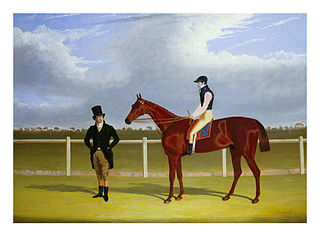
Rowton (1826–1841) was a British-bred Thoroughbred racehorse and sire best known for winning the St Leger Stakes in 1829. He was lightly campaigned during his racing career, competing in eleven races in five seasons and winning seven times. Until his last competitive season he was raced exclusively in Yorkshire running only at the meetings at York in August and Doncaster in September. Apart from the St Leger, his wins included the York Two-year-old Stake, the Great Subscription Purse and a division of the Oatlands Stakes. On his final appearance he ran a dead heat for the Ascot Gold Cup before being beaten in a run-off by the filly Camarine. After three seasons at stud in England he was exported to the United States where he died in 1841.
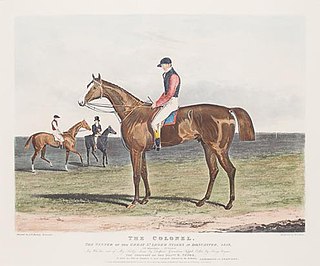
The Colonel (1825–1847) was a British-bred Thoroughbred racehorse and sire best known for running a dead heat in The Derby and winning the St Leger Stakes in 1828. In a racing career which lasted from 1827 until 1831, The Colonel ran fifteen times and won ten races at distances ranging from six furlongs to three miles. Apart from the St Leger, his most notable successes came in the Champagne Stakes, the Epsom Craven Stakes (twice), the Great Park Stakes at Ascot and the Northampton Gold Cup. He was also placed in both the Ascot Gold Cup and Goodwood Cup.

Margrave (1829–1852) was a British Thoroughbred racehorse and sire best known for winning the St Leger Stakes in 1832. In a racing career which lasted from June 1831 until April 1833 he ran ten times and won six races. He was one of the leading British two-year-olds of 1831, when his three wins included the Criterion Stakes at Newmarket and he was one of the favourites for the following year's British Classic Races. He finished fourth in The Derby, allegedly being held back to allow another of his owner's horses to win. In autumn he won the St Leger and the Grand Duke Michael Stakes but ran poorly on his only race as a four-year-old the following spring. He was then retired to stud where he had some success as a sire of winners in both the United Kingdom and the United States.

Chorister (1828–1833) was a British Thoroughbred racehorse best known for winning the classic St Leger Stakes in 1831. In a racing career which lasted from May 1830 until October 1831 he ran seven times and won four races. In the St Leger he was not regarded as a serious contender but was given an extremely well judged ride by John Barham Day to win by a short head from The Saddler. Chorister remained in training for two further seasons but never raced again and died in the autumn of 1833.
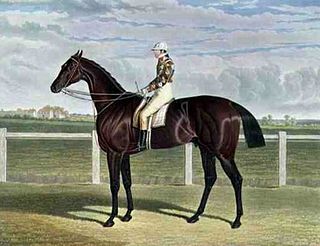
Rockingham was a British Thoroughbred racehorse and sire best known for winning the classic St Leger Stakes in 1833. After finishing fourth on his only appearance as a two-year-old, the colt was undefeated in three starts in 1833, winning the St Leger in the harlequin colours of Richard Watt and taking the Doncaster Cup against older horses in the same week. Rockingham remained in training for three further seasons, winning the 1835 Goodwood Cup, four King's Plates, and three consecutive renewals of the Brighton Gold Cup. He was retired from racing for a brief stud career, but had little success as a sire of winners.

Memnon was a British Thoroughbred racehorse and sire best known for winning the classic St Leger Stakes in 1825. In a racing career which lasted from 1824 until 1828 he ran fifteen times and won nine races. Bred and originally trained in Yorkshire, he was unbeaten in two races as two-year-old in 1824, including the Champagne Stakes and won the York version of the St Leger the following spring. In the St Leger at Doncaster in September 1825, he was successful as the heavily backed favourite in a record field of thirty runners. Memnon was later trained at Newmarket and recorded his most important subsequent victory when winning the Ascot Gold Cup as a five-year-old in 1827. After standing as a breeding stallion for five years in England with moderate results, he was sold and exported to Russia.

Jerry was a British Thoroughbred racehorse and sire best known for winning the classic St Leger Stakes in 1824. In a racing career which lasted from 1824 until 1827 he ran ten times and won five races. Unraced as a two-year-old, he was beaten on his first appearance in 1824 but then won the York St Leger and the XYZ Stakes at Newcastle before defeating twenty-two opponents in the St Leger at Doncaster. Jerry missed the entire 1825 season and showed little form in 1826, but won twice as a six-year-old in 1827. He was retired to stud, where he proved to be a successful sire of winners.

Barefoot (1820–1840) was a British Thoroughbred racehorse and sire best known for winning a chaotic and controversial race for the classic St Leger Stakes in 1823. Bred and originally trained in Yorkshire, Barefoot was beaten on his debut but began a seven race winning sequence when successful in a minor race at Pontefract in September 1822. As a three-year-old he was unbeaten in five starts including the Spring St Leger at York and the Great St Leger at Doncaster. In the latter event, he finished second in a race which was declared void after a false start before winning a re-run. Barefoot was later sold to William Vane, 1st Duke of Cleveland and competed for three further seasons with mixed results, his best efforts being wins in the Lancaster Gold Cups of 1825 and 1826. After his retirement from racing he was exported to the United States where he had limited success as a sire of winners before dying as a result of a snake bite in 1840.

Theodore was a British Thoroughbred racehorse and sire best known for winning the classic St Leger Stakes in 1822 at odds of 200/1. Trained in Yorkshire by James Croft, he won the second of his two races as a two-year-old and showed good form the following year, winning races at Catterick, York and Newcastle. His St Leger prospects, however, appeared remote after health problems and poor performances in training gallops. His upset win in the classic, followed by a poor run over the same course and distance two days later, attracted a great deal of comment and suspicions of race-fixing, although none of the allegations was ever proved.

St Patrick (1817–1843) was a British Thoroughbred racehorse and sire best known for winning the classic St Leger Stakes in 1820. He was unbeaten in four races as a three-year-old, culminating with a success against twenty-six opponents in the St Leger at Doncaster Racecourse. In the following year he won Gold Cups at York and Pontefract before being defeated in the Fitzwilliam Stakes at Doncaster. He was then retired to stud where he had some success as a sire of winners.

Mango was a British Thoroughbred racehorse and sire best known for winning the classic St Leger Stakes in 1837. He won nine of his thirteen races in a racing career which lasted from October 1836 until October 1838. Mango was well-beaten in his only race as a two-year-old and finished unplaced in The Derby but won three races at Royal Ascot in June. In September he won an exceptionally rough race for the St Leger at Doncaster Racecourse and then won the Newmarket equivalent a month later. Mango won twice in the following year, but became increasingly temperamental and difficult to manage. He was retired to stud at the end of 1838 but proved a failure as a sire.
